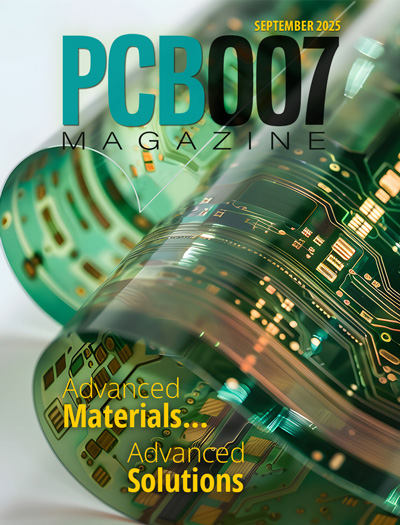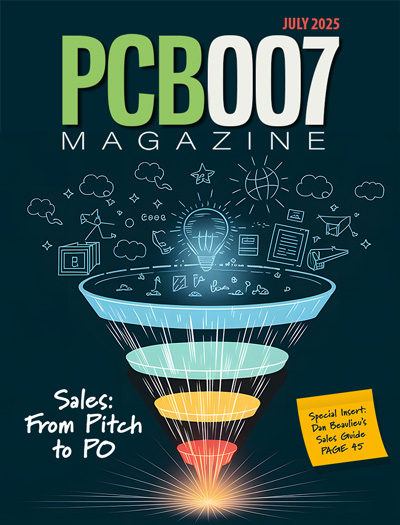-

-
News
News Highlights
- Books
Featured Books
- pcb007 Magazine
Latest Issues
Current Issue
Advancing the Advanced Materials Discussion
Moore’s Law is no more, and the advanced material solutions to grapple with this reality are surprising, stunning, and perhaps a bit daunting. Buckle up for a dive into advanced materials and a glimpse into the next chapters of electronics manufacturing.

Inventing the Future With SEL
Two years after launching its state-of-the-art PCB facility, SEL shares lessons in vision, execution, and innovation, plus insights from industry icons and technology leaders shaping the future of PCB fabrication.

Sales: From Pitch to PO
From the first cold call to finally receiving that first purchase order, the July PCB007 Magazine breaks down some critical parts of the sales stack. To up your sales game, read on!
- Articles
- Columns
- Links
- Media kit
||| MENU - pcb007 Magazine
Estimated reading time: 2 minutes
The Velocity of Technology— What Does It Really Mean?
Speed and Direction— Where Are we Going?
The subtitle of IPC APEX EXPO 2018 was “Succeed at The Velocity of Technology.” What did IPC mean by this?
I have not asked the IPC staff what this phrase meant in real terms, but I have my own interpretation. For me, the velocity of technology has two components: speed and direction. The technology in electronics develops faster than ever. A user of mobile phones or computers may not understand the rate at which electronics changes, but if you see the development of components and the complexity of today’s packages, you understand the speed.
Driving a car is probably one of the areas where the user comes in direct touch with the technology development. And we understand the speed when we see how fast we get new versions of smartphones and other gadgets. But in what direction are we going? We all know that size and weight reduction is good. We get more function into the same space. At the same time, we increase the functionality— a mobile phone today can do more than a desktop computer did some years ago. It has a better camera than the reasonably good full-size digital camera we still have in our drawers.
I am a PCB geek. For me, it is interesting to see how technology development has affected the PCB, and in which direction we move. How do we see the velocity of technology in PCBs?
(Almost) Born and Raised in a PCB Plant
I was born in a PCB plant outside Oslo in June 1958. Norway had no PCB factories at that time, so my father saw the potential and started to etch boards in a garage using silkscreened etching resist and ferric chloride etchant. The boards had to be used fast to avoid corrosion; we only had a simple lacquer to protect the copper.
Time went by and at 20-something I was set to lead a small PTH plant. We started to use photoimageable plating resist and infrared re flow for tin-lead (those machines typically had a small fire every week). At that time, we had no RoHS, REACH or ISO 14000 or really any environmental awareness. I have some stories that are better told in more private circles.
In 1992, I joined Elmatica and during the ‘90s we saw some development of PCB technology but mostly just a slight miniaturization. Frankly speaking, the PCB technology itself has not changed that much today either. We still print and etch. We still drill, but we use a laser in addition to the mechanical drills. We still print solder mask, we still plate copper to achieve required thickness and through-hole connections. So, we have seen some changes, but not the speed or change of direction as in other technologies.
The velocity of PCB technology today is still, from my point of view, not at the same rate as we see in components. The introduction of smaller components has almost out-challenged the PCB. But only just. And, we are still in the same direction, so we cannot brag too much about the velocity of the PCB technology.
To read the full version of this article which originally appeared in the May 2018 issue of PCB007 Magazine, click here.
More Columns from The PCB Norsemen
The PCB Norsemen: New Trends in the PCB Industry at productronica 2019The Laminate Market: What Will the Future Bring?
The PCB Norsemen: Avoid Failures in PCB Production With Compliance Control
The PCB Norsemen: From Wooden Huts to Homemade Go-karts—It All Starts With Design!
What Is Reliability Without Traceability?
The PCB Norsemen: Merging the Best of Both Worlds—Young Superheroes and Knowledgeable Wizards!
The PCB Norsemen: My Flexible Story—Flex Circuit Development Through the Decades
A PCB Broker’s Guide Through the Galaxy of Automation


